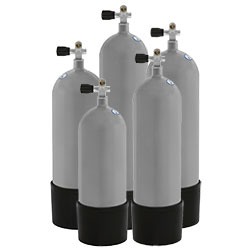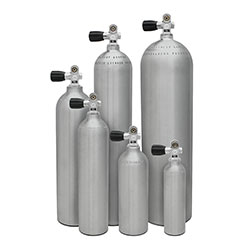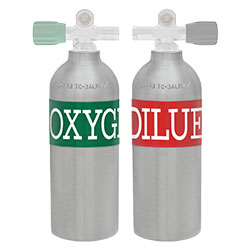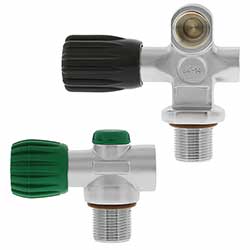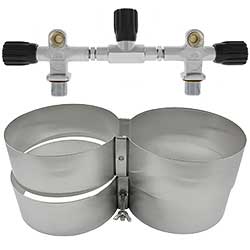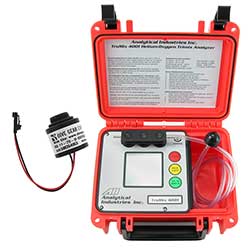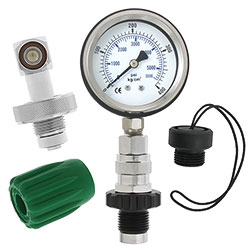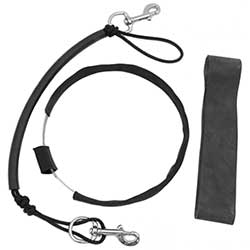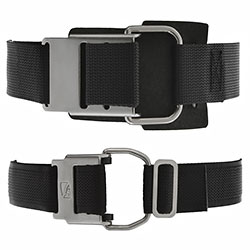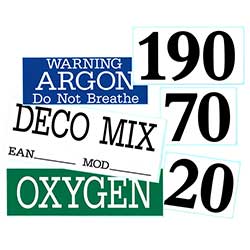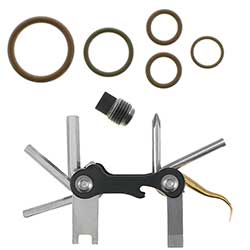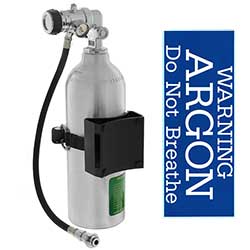This is a detailed article focused on helping divers choose the best SCUBA tank for their specific needs and styles of diving.
Tank Definition
The actual proper name for the big heavy thing we use to go diving is a cylindrical pressure vessel. A tank is the proper term for an unpressurized container like a fuel tank. The people who make pressure vessels for diving, call them high pressure compressed gas SCUBA cylinders. When the cylinder and valve are discussed as a single unit, SCUBA tank or dive tank is the term used by nearly all divers. For the purposes of this article, we'll adopt the term "tank", but you may find elsewhere on our site that we refer to them as cylinders. All SCUBA tanks would technically be considered "high pressure" vessels, but within the recreational diving community the terms "low", "standard", and "high" are often used to describe dive tank service pressures and we will continue to use that convention within this article. Finally, the information in this article is focused on recently manufactured scuba tanks currently sold in the United States.
Tank Choices
There are several SCUBA tank manufacturers, and the specifications for their tank pressures, dimensions, and capacities are constantly changing. Divers can choose between SCUBA tanks manufactured from aluminum or steel. Dive tank pressures span a wide range, but the most common pressures are "low" (2400 to 2640 psi), "standard" (3000 psi), and "high" (3300 to 3500 psi). They are available in a huge selection of capacities as the primary dive supply ranging from 50 cubic feet to 150 cubic feet. Tank coatings fall into three general classifications of painted, galvanized, and uncoated. This article will help guide divers in the selection of tanks. However, keep in mind that there is no "perfect" tank for all diving conditions and all divers.
The Big Lie About Capacity
It's important to know that service pressure alone does not determine capacity. All tanks have a mathematical relationship between their internal volume, their maximum service pressure and their actual free gas capacity. Volume is defined by the internal dimensions of the tank, and normally measured in cubic inches or liters of water. Free capacity is defined by the amount of breathing gas released at the surface that the scuba tank will hold at its maximum rated service pressure. Determining the actual capacity from the water volume and service pressure is troublesome, because not everybody does their math quite the same way. In fact, several tanks actually hold much LESS air than the size used to describe them. For example, the "standard" aluminum 80 (AL80) truly holds only about 77 ft3 of air and the steel "low pressure 85" truly holds only about 81 ft3 of air. Technical divers must keep in mind the free capacity can be 10% to 20% LESS for Trimix than for air. For a very technical explanation, you could read our article titled Calculating SCUBA Cylinder Free Capacities. But for now, just remember that because a tank has a higher maximum service pressure doesn't mean it has "more air" and that tank marketing descriptions may overstate their capacity.
Selecting a Tank Capacity for Sport Diving with Air
Start with the benchmark of the AL80 that actually holds about 77 cubic feet of gas at 3000 psi. This is plenty of gas for the experienced air diver, and usually the air no-stop-required time is what limits the dive. The most consistent complaint about the aluminum 80 is its poor buoyancy characteristics. The AL80 tank is positively buoyant near the end of the dive, requiring the diver to offset that buoyancy by carrying additional weight in order to achieve neutral buoyancy on their safety stop.
If your gas consumption is sometimes the limiting factor on your bottom time, you might choose a larger tank like the high-pressure steel 100 (HP100). The aluminum 100 is the largest aluminum tank available, but at a weight of 40 pounds, is considered quite heavy. The HP100 is the same weight as aluminum AL80, but has a service pressure of 3442 psi. The HP100 is the most popular steel tank chosen by sport divers, in part because of the excellent buoyancy characteristics as compared to aluminum.
On the other hand, If you usually return to the boat with 1000 psi or more of gas in an AL80, then you might consider a smaller tank such as the Aluminum 63 (AL63). Obviously, one advantage of the smaller tank is less weight to carry and haul up the boat ladder, but more important are significantly improved buoyancy characteristics over the AL80. An excellent compromise solution, if 80 cubic feet of gas is enough but you don't want to deal with the buoyancy hassles of the standard aluminum 80, is the high-pressure steel 80 (HP80) and the low-pressure 85 (LP85). The HP80 and the LP85 have a little more capacity (remember the AL80 capacity is only 77 cubic feet) and the much better buoyancy characteristics of steel, yet are the same weight or even slightly less weight than the AL80. Many individuals find they slightly prefer the trim of the LP85 over the HP80.
Selecting a Tank Capacity for Sport Diving with Nitrox
Diving on Nitrox does change our recommendations. Nitrox divers are more often limited by the volume of their tank, because they tend to stay down longer. Even if they are using the Nitrox advantage for safety with an air table, Nitrox divers usually push the air limits right to the edge because they know they have the advantage of the additional time margin granted by the Nitrox. Again, the HP100 is very popular among sport Nitrox divers. Nitrox divers using the Nitrox advantage for time stay down a LOT longer, and their tank of choice is usually one of the very large tanks. They might choose the high-pressure steel 117 (HP117), high-pressure steel 120 (HP120) or sometimes even the high-pressure steel 133 (HP133). Later in this article, there is some further discussion regarding use of oxygen rich gases in cylinders.
Selecting a Tank Capacity for Technical Diving
More is not always better, and you should match your tank capacity to your gas requirements. If you are not going too deep or staying too long, use an H-valve with a single HP133. Staying with a single tank streamlines your profile and reduces buoyancy compensation resulting in improved gas consumption. If you need more gas, then choose double HP117s for open water and wreck diving. Cave divers like double HP133s, but for many divers, they are unnecessarily heavy and cumbersome for technical diving done from boats. We've seen even larger doubles configurations, but divers using them typically need assistance to get in and out of the water. Some divers choose double AL80s, but these become so buoyant near the end of the dive that they work best with a 7-pound trim weight. Divers with a smaller stature often find double LP85s have a trim better suited to their body type.
Keep in mind that NO size of doubles cylinders may be appropriate for your open-circuit technical diving gas needs because the depth range generally considered to be reasonable for technical diving has been gradually increasing. Divers of small stature diving below 200 feet, particularly smaller women and even ordinary divers going very deep, may not be able to wear enough buoyancy control to safely offset the weight of the equipment needed to meet gas requirements when following rule-of-thirds. Because of this, many open-circuit technical divers are now switching to closed-circuit rebreathers as a solution to reducing the volume of open-circuit gas needs.
For deco tanks the aluminum 19s (AL19) and aluminum 40s (AL40) are most popular. The AL19 has become popular as an oxygen deco tank, because it's compact and 19 cu ft of oxygen is plenty for all but the most extreme dives. The AL19 also makes an excellent choice as a bailout for rebreather divers or a pony for sport divers. For stops in the 70 to 30 foot range on rich Nitrox mixtures, the AL40 has become the cylinder of choice. For deep stops in the 200 to 100 foot range, or if you are doing decos so long that you want to take a nap on your stops, the deco tank of choice is the aluminum 72 (AL72).
Selecting a Tank Capacity for Sidemount Diving
Sidemount configurations offer considerable advantage over trying to manage the weight of larger back mount cylinders. The streamlined profile of the sidemount diver normally results in significant improvements in gas consumption as compared to back mount doubles sets. For sidemount diving, the tank buoyancy characteristics and diameter become more relevant to selection. Nearly any cylinder size can be used to sidemount, but probably the most popular sidemount choice is a pair of aluminum AL80s and we've also seen AL72s selected for their preferred trim characteristics over AL80s. Because steel offers additional weight we've seen many pairs of steel LP85 cylinders used by sidemount divers wearing drysuits. The smaller steel LP50's have also been popular for sidemount applications. We've seen big cylinders used for sidemount when the dive plan required larger capacity, but 8-inch diameter steel cylinder sidemount configurations are rare with the usual explanation being a set of cave diving doubles were split and pressed into sidemount service.
Gases Containing More That 23.5% Oxygen
Federal law prohibits the dispensing of pure oxygen at pressures over 3000 psi in DOT-3AL type cylinders, and this would include most aluminum scuba cylinders since nearly all are 3AL class. Recently, the DOT has interpreted this regulation to include any gas mixture containing more than 23.5% oxygen, i.e. enriched air Nitrox. You should avoid high pressure aluminum scuba tanks such as the 3300 psi compact or neutral buoyancy aluminum tanks, or the 3300 psi AL100. Note that this concern does not apply to high pressure steel cylinders, depending on the service pressure of the scuba cylinder it may be filled with oxygen rich gases up to a maximum of 3442 psi.
Some retailers only offer scuba tanks suitable for use with Air, which contains approximately 20.9% oxygen. To use enriched air Nitrox and many of the gases used in technical diving, you must purchase a cylinder and valve that the retailer has assembled and marked as both oxygen compatible and cleaned for oxygen service. Nonetheless, the 'clean state' of the equipment applies only prior to initial use. Thereafter, periodic inspection and cleaning are a necessity. The Compressed Gas Association describes in their pamphlet CGA G4.1 "Cleaning Equipment for Oxygen Service", the methods for inspecting and cleaning equipment used in the production, storage, distribution and use of oxygen.
Our Nitrox Ready SCUBA Tanks are oxygen compatible and factory oxygen cleaned, prior to initial use. However, most suppliers in the dive industry specify their Nitrox Ready products for use with gas mixtures containing a maximum value of 40% oxygen. Recently we've noticed a few dive retailers have started describing their SCUBA tanks, as "Nitrox Ready up to 23.5%". There is no standardized definition of Nitrox Ready, but our interpretation of that unusual statement is the retailers are essentially saying the product is only suitable for use with Air. We think that has the potential to be very misleading if the product is not oxygen clean or oxygen compatible.
You must meticulously follow the recommendations of the Department of Transportation (DOT), Compressed Gas Association (CGA), and other federal/state/local agencies, plus your dive training agency for equipment maintenance, handling, storage, labeling, filling, transport and use of compressed gases containing oxygen. The Compressed Gas Association describes in their pamphlet CGA P-1 "Safe Handling of Compressed Gases", the guidelines for proper handling of compressed gases containing oxygen.
Hydrostatic Testing and Visual Inspections
All SCUBA tanks should receive periodic formal visual inspections (VIP) by a trained inspector and must receive a periodic hydrostatic pressure test (aka "hydro") and VIP by a US Department of Transportation (DOT) approved test facility. Nearly all SCUBA fill stations require annual VIPs, and they are considered to expire one year (12 months) following the inspection. A DOT required hydrostatic test expires five years (60 months) following the test. Because neither a visual inspection sticker nor hydro retest mark normally indicate the day of the month performed, a long established and widespread practice in the SCUBA industry has been the valid period expires on the first day of the month shown. Recently, the DOT has issued a clarification statement that the hydrostatic test officially expires on the last day of the month shown.
When purchasing a new cylinder, the remaining life of the original factory hydro test can vary considerably. For AL80s, the most popular scuba tank where the inventory turns over rapidly, the hydro test date will likely be well within the last 12 months. For less popular tanks the hydro test date can be considerably older as specific volume and pressure configurations may only be manufactured once every two or three years. At the time of purchase, you should consider any hydro test date less than 24 months old to be acceptably recent. For popular size tanks with hydro test dates older than two years, the retailer might be willing to decrease the price by about ten dollars for each year over the first two.
Aluminum Tanks versus Steel Tanks
In general, most experienced divers prefer the buoyancy characteristics of steel tanks to those of aluminum. Aluminum tanks tend to shift from negative to positive buoyancy as the diver consumes the contents. This requires the diver to carry additional weight at the start of the dive in order to be properly weighted at the end of the dive. Steel tanks shift from negative to neutral buoyancy, and this allows the diver to begin the dive with less weight and still be properly weighted at the end of the dive. There is a line of aluminum "compact" high pressure tanks that offers somewhat improved buoyancy characteristics when compared to standard aluminum tanks. However, some divers felt the uneven distribution of weight in the early designs of compact aluminum tanks caused them to be bottom-heavy in the water and they have not proven to be popular although later designs addressed that concern.
Both steel and aluminum corrode in the presence of sea water. Steel tanks produce corrosion that consists of iron oxide and iron hydroxide (in the presence of water), while aluminum tanks produce corrosion in the form of aluminum oxide and aluminum hydroxide (again, in the presence of water). Regardless of the metal, the corrosion can occur rapidly in the right conditions and can significantly shorten tank life. With properly cared for tanks, corrosion is not an issue no matter what type of metal. However, for tanks that have not received proper care, corrosion is a major concern. Internal corrosion and line corrosion around the boot are the most common reasons both steel and aluminum tanks fail inspection.
Because steel is stronger and more ductile than aluminum, construction of a tank requires less steel than aluminum. This usually means that for an equal gas capacity, a steel tank will have a total weight less than an aluminum tank yet have better buoyancy characteristics. For example, the standard aluminum 80-cubic-foot tank weighs about 35 pounds, while similar capacity steel tanks weigh in at about 30 pounds.
There have been lengthy discussions about the service life of steel tanks vs. aluminum tanks. The service life of a properly cared for modern steel scuba tank is widely considered to be 50 years or more. The service life of a properly cared for aluminum tank is more controversial, but some dive shops won't fill an aluminum tank manufactured before 1990 due to concerns regarding sustained load cracking of aluminum alloys in wide use prior to that date. Aluminum tanks are particularly susceptible to damage from heat. During the manufacturing process, the aluminum tank is strengthened using a special heating and cooling process. If an aluminum tank is later heated beyond 350°F, the tank walls lose their strength and the tank fails at normal service pressures.
The final consideration of aluminum vs. steel is the price. The initial purchase price of aluminum tanks is significantly less than comparably sized steel tanks. However, many people feel that when the costs are amortized over the life of the tank, the true costs are roughly equal.
Low-Pressure Tanks versus High-Pressure Tanks
The most common service pressures seen in modern SCUBA tanks are 2640 psi, 3000 psi, 3300 psi, 3442 psi, and 3500 psi. Traditionally, 2640 psi low-pressure steel tanks are preferred by Nitrox and technical divers who expect to be blending their gases using the partial-pressure method. Most aluminum SCUBA tanks are rated for 3000 psi. The compact aluminum tanks and the standard AL100 tank have a service pressure of 3300 psi. The availability of modern design high-pressure 3442 psi steel tanks manufactured under DOT Special Permit (previously termed an exemption from the old 3AA class design) caused many experienced divers to re-think their tank preferences. Although there are 3500 psi cylinders still in service, current DOT rules prohibit the transport of metal scuba cylinders on public roads with pressures above 3442 psi (230 bar), even if the cylinders have been rated for higher pressures.
The lowest service pressure is best from the point of view of equipment. The higher the pressure, the more stress on regulator and valve components, such as O-rings and seats, increasing the likelihood of a failure. At 3442 psi, the high-pressure seat of the regulator first stage is often the first component to fail, particularly if the diver has been careless and often opens the tank valve very rapidly. However, most modern scuba equipment can easily handle the higher pressures and today these concerns are very minor. The high-pressure 3442 psi steel tanks offer the advantage of more compact size when compared to similar volume low-pressure steel tanks and even some aluminum tanks.
A few types of steel tanks can be qualified for a 10% increase in service pressure during their periodic hydrostatic tests. This is indicated by a "+" mark following the hydrostatic test stamp. For example, a 2400 psi tank with a "+" has a service pressure of 2640 psi. An extra step in the hydro test process must be performed in order to qualify the tank for a "+" mark. It's always performed on the first factory hydrostatic test, but often overlooked on subsequent periodic five year tests in the field. Technically, its absence means that it no longer qualifies for the increased service pressure, but in reality its absence almost always means the additional step was never performed. Regardless, the absence of the "+" mark on subsequent hydro stamps is often ignored by dive shop fill station operators who fill to the higher service pressure anyway.
Dive Gear Express does not advocate filling dive tanks beyond their service pressure, a practice termed "overfilling" or "jamming". Overfilling occurs primarily in the technical diving community but is occasionally seen in the Nitrox sport-diving community as well. Although the dangers and risks of overfilling is a separate discussion, modern tanks are sometimes overfilled in order to gain increases in capacity. Irrespective of the risks, overfilling is also a logistics hassle because most fill stations will not overfill and it requires changing or defeating the burst disks in the valve.
In our experience, many dive shops consistently under fill certain high-pressure tanks. Fill station operators will often assume all aluminum tanks are filled to 3000 psi, causing the 3300 psi service pressure aluminums to receive short fills. We've also noticed that the very high capacity tanks like the 3442 psi HP133 are also sometimes under filled when they are near empty because they heat up so much due to the large amount of gas being delivered.
One idea we like is selecting a large-capacity high-pressure steel tank and then routinely deliberately under fill it to 2700 - 3000 psi. For example, the 3442 psi HP100 yields 89 cubic feet at 3000 psi, and 80 cubic feet at 2640 psi. That is plenty of gas for most dives, puts an end to short fill hassles, yet allows the option of a high-pressure fill when you need really need more gas. This is how divers have for years been using overfilling with low-pressure tanks, but with the advent of the large-capacity high-pressure tanks, it eliminates the concerns regarding overfills. The new high pressure cylinder buoyancy, weight and balance characteristics are very similar to, actually a little better than, low pressure cylinder characteristics. So if you want an LP cylinder, simply underfill the HP cylinder to receive the lower capacity. Remember, you always have the option of filling to the higher pressure and capacity should the need arise.
Yoke and DIN Valves
Although a discussion of the merits of yoke versus DIN valve and regulator fittings is outside the scope of this article, some issues need to be addressed. In the past, the most common type of valve found on aluminum and low-pressure steel scuba tanks was the classic yoke K-valve. More recently, many divers have been using a 200-Bar DIN valve that fits aluminum and low-pressure steel tanks. This valve also accepts a small screw-in adapter that allows the DIN valve to be converted for use with yoke-type regulators. All high-pressure 3500 psi steel tanks had a smaller neck opening that accepted only a 300-Bar DIN valve, for which no yoke adapter existed and thus required a 300-Bar DIN fitting regulator. With one rare exception, there no longer any scuba tanks being manufactured that require a 300-bar DIN fitting.
In 2003, a modern a high-pressure (3442 psi) tank design having weight and buoyancy characteristics of low-pressure tank designs was introduced with the same neck threads as aluminum and low-pressure tanks. The tanks are normally offered with a 200-Bar DIN valve and yoke adapter installed. However, we have seen some yoke regulators with the yoke assembly marked for 3000 psi max service (or unmarked), and we do not recommend using those yoke regulators on the high-pressure tanks.
Tank Dimensions & Weight
Cylinder specifications are described as "nominal", which is another way of saying approximate. Minor variations in the length and weight of cylinders are commonplace, although less so for diameter. In practice, due to variations in wall thickness (especially at the base and neck) actual buoyancy varies as much as ±2 pounds from specifications in larger primary cylinders, especially for steel cylinders. When assembling doubles, these differences in length may be more noticeable and when Dive Gear Express assembles doubles we make an effort to select a pair of cylinders that have similar length. We occasionally encounter individuals who pour over cylinder buoyancy specifications in search of the "perfect" cylinder for their application. Because so many other factors affect buoyancy, these variations in dimensions and weight are not normally significant and have very little impact on the dive in practice.
For most people, the standard AL80 at 26 inches in length is a bit too long to be comfortable. The steel HP100 at 24 inches in length seems a little better for the average diver and the fatter HP117 is also very manageable at 24 inches. The AL63 and the HP80 at 21 inches are a nice length for divers of smaller stature. For children and very small divers the HP65 at 17-inches is a good choice. The really large-volume tanks like the HP120 and the HP133 that range from 28 to 30 inches in length are a bit unwieldy for most divers, but a viable choice for tall divers over six feet in height. With longer tanks, you must take care when you set your BC harness to make sure it's not too low on the body of the tank. Otherwise, you may hit the back of your head on the regulator first stage when you enter the water.
| Height | Tanks |
| 20-21 Inches | AL63, HP80 |
| 24 Inches | HP100, HP117 |
| 26 Inches | AL80, AL100 |
| 28-30 Inches | HP120, HP133 |
Tank diameters are a more significant consideration. Most primary tanks, aluminum or steel, are the common diameter of 7-¼ inches. The AL100 and some of the larger-capacity high-pressure tanks, such as the HP117 and HP133, are also 8 inches in diameter, although the HP120 is a 7-¼ inch tank. Your BC will fit the 8-inch diameter tanks just fine, but if you have to switch it back and forth between two different tank diameters, constantly readjusting the BC tank band(s) can be annoying. Also, some dive boats have tank storage racks that don't accommodate the 8-inch diameter tanks very well.
Tank Exterior Paints, Coatings, and Finishes
Standard aluminum tanks are available in a very wide range of colors. Steel tanks and the smaller aluminum tanks (i.e., less than 50 cu. ft. in volume) are often available only in a very limited selection of colors. At any given time, the availability of specific colors on specific sizes is very erratic due to relatively small production runs.
With aluminum tanks, it seems that most coatings do more to encourage corrosion than to prevent it. Modern formulation (read 'environmentally friendly') paints on aluminum tanks just do not seem as durable as previous generation coatings and do not adhere well, often beginning to peel and flake with even limited exposure to saltwater. Once water makes its way under the paint, corrosion is actually encouraged. The opaque paint colors hide any corrosion that might be occurring underneath the paint. Clear-coat and translucent colors allow the corrosion to be visible, but our experience has been for some reason these finishes are even less durable and promote even faster corrosion.
The aluminum tank finishes of choice are unpainted: natural, shot blast, and brushed. The natural finish is just the appearance of the cylinder immediately after heat treatment when it forms a natural streaked gray aluminum oxide coating that is cosmetically unappealing. Shot blast is the natural surface that has been textured and is a uniform dark gray. Decals and stickers do not adhere well to shot blast. The natural surface that has been brushed to a uniform shiny finish is the most popular of the unpainted finishes, but all the unpainted finishes hold up very nicely and do not encourage or hide corrosion.
Uncoated steel tanks quickly rust in the presence of water, so all steel tanks are coated with zinc. When a steel tank is galvanized, a zinc metal coating is bonded to the surface of the steel. There are two zinc coating processes for steel tanks: dip galvanizing and spray galvanizing. The hot zinc dipped coating comes from the factory as a shiny silver color that rapidly ages to a mottled gray once exposed to sea water. Steel tanks are also available in a hot zinc sprayed coating that is further protected with an epoxy paint. Compared to the better cosmetic appearance of the epoxy paint finish, the hot-dipped galvanized finish is "industrial grade" with noticeable cosmetic imperfections. Although the consensus seems to be that hot-dipped galvanization is preferred for its resistance to scrapes and scratches, some experts believe that environmental concerns about the molten zinc dip vat operation itself outweigh the benefits of hot-dipped galvanization.
After an absence in the market for several years, in the Fall of 2016 a hot-dipped galvanized finish on steel scuba cylinders was re-introduced. However, as of 2025, the hot dipped galvanized (HDG) finish on new cylinders again became unavailable. We being told by our US distributors that Faber is exploring alternative sources for HDG, but the future availability of the HDG finish on new SCUBA cylinders is uncertain at this time. Used SCUBA cylinders with HDG finish may be found in the secondary market, but often at a premium price.
We have heard many debates on the corrosion resistance and durability of dipped versus sprayed and painted steel tanks. In fact, we have seen steel tanks of every type and manufacture in excellent condition after many years of heavy service and we have also seen them fail the first annual inspection. The truth is both types of steel tanks will give many years of service when they receive proper care. All tanks must be thoroughly rinsed in fresh water after use in salt water and during storage the boot should be removed. Both unpainted and painted steel tanks require some additional care in comparison to unpainted aluminum. Any deep scratches that cut through the galvanizing and expose bare steel need to be touched up with either a rust-inhibiting paint or a cold-galvanizing compound, both available in aerosol sprays and brush applicators at hardware stores.
Tank Cosmetics
Ongoing changes in the cylinder industry (most recently the exit of the SCUBA cylinder business by major suppliers of both aluminum and steel products) has currently left the consumer with very limited choices in an extremely competitive and highly price sensitive market. The recreational dive industry has long been accustomed to a "consumer grade" finish on SCUBA cylinders. Now new cylinders may often present with what could be charitably described as an "industrial grade" internal and/or external surface appearance that is similar to what is typical of bulk supply cylinders. The surfaces can have streaks of discoloration, spotting, and various other irregularities as a byproduct of manufacturing and testing.
Currently, all the cylinder manufacturers are adamant in maintaining the position that their SCUBA cylinders are O2 clean and fit for purpose as delivered from the factory. This puts the distributors and retailers of SCUBA cylinders between a "between a rock and a hard place" when unqualified inspectors or consumers object to the appearance. If the distributor or retailer does any modifications (such as further cleaning, tumbling or grinding) to the brand new cylinder warranted as O2 clean and fit for purpose from the manufacturer, then legal responsibility for the condition of the cylinder shifts to the aftermarket service provider. A cylinder with aftermarket treatments also technically can no longer be represented as new and O2 clean from the factory. Most retailers choose to follow the experts in this circumstance - the manufacturer plus the independent testing agency plus the certified cylinder visual inspector that all warrant a brand new and unused cylinder is fit for purpose.
However, there are unscrupulous dive shops and unqualified inspectors that use the industrial grade surface appearance of aluminum cylinders or a light bloom of rust on steel cylinders as an excuse to reject the cylinder and unnecessarily charge for a tumble & cleaning service. Tumbling to remove discoloration on aluminum interiors or slight amounts of rust on steel interiors is not a benign service. Tumbling removes metal thus thinning the cylinder wall as well as exposes the underlying surface such that corrosion may be later accelerated. The practice by shops and individuals of aftermarket cleaning for new dive equipment that is already oxygen clean from the factory is pointless at best and dangerous if done improperly. In new cylinders, represented by the manufacturer as suitable for oxygen service, tumbling is not appropriate and should rarely be needed for cylinders already in service. If the shop or inspector claims a new cylinder requires aftermarket cleaning, then you should seek a second opinion from a certified cylinder inspector or return the cylinder to point of purchase.
The bottom line is that all SCUBA tanks will have cosmetic imperfections from the factory and recently the cosmetic quality has noticeably declined. However with just minimal care, all tanks regardless of their cosmetics will deliver many years of service. We occasionally encounter consumers who seem prioritize the cosmetic appearance of their tanks over more significant considerations. Since the shipping on cylinders is not free, our advice to those consumers is they should reconsider their priorities. Otherwise, if cosmetics is important to ownership, they might prefer renting tanks rather than owning or purchasing locally where they may personally inspect before purchase.
Tank Manufacturers
Even similar-capacity tanks from various manufacturers often differ in their weight, dimensions, buoyancy, and finishes. Some sizes and service pressure combinations are available only from a specific manufacturer and/or distributor. Several dive equipment distributors market these same tanks under various brand names. The cylinder market has been in considerable upheaval in recent years as the result of bankruptcies, acquisitions, mergers and plant closings. It can get pretty difficult to follow... the exact same aluminum scuba cylinder, produced using the same tooling, raw materials and workmanship has been produced by a succession of different company names: first Hy-Mark, then Piper, then Worthington, then Metal Impact, which has now rebranded as Thunderbird which is distributed by both XS Scuba and Sea Pearls (which is owned by XS Scuba).
Just a handful of companies currently produce SCUBA tanks for the U.S. market. Only Catalina and Thunderbird manufacture aluminum scuba tanks in the US. (In March 2021, Thunderbird announced it has expanded production capacity by acquiring the Luxfer aluminum gas cylinders operations.) We've seen some AL-80 Chinese manufactured aluminum scuba tanks exported for the U.S. market under the Cyl-Tec brand name. Faber of Italy manufactures and exports steel SCUBA tanks for the U.S. market under the Blue Steel and XS Scuba brand names. We detect no difference in quality among the products from any of the SCUBA cylinder manufacturers. That's as expected, given the cylinders are all manufactured to DOT specifications and each cylinder must pass inspection and testing by an independent agency.
We have found the Thunderbird (formerly known as Metal Impact) brand offers a little better price and availability, with no compromise on quality, as compared to Catalina and Luxfer. Experienced divers have always preferred the Luxfer over the Catalina because the Luxfer cylinder offers better buoyancy and trim characteristics for stage and sidemount applications. The good news is we find the Thunderbird cylinders to have equal or slightly better buoyancy and trim than even the old Luxfers. Faber is currently the only option for those divers seeking recently manufactured galvanized steel scuba tanks.
Impact of Tariffs on Prices
Recently the United States has placed a 25% import duty on the special aluminum alloy that is used to manufacture aluminum cylinders and 50% import duty on the special steel alloy that is used to manufacture steel cylinders. Unfortunately, the issues of simply switching to domestic suppliers for these materials is complex lengthy process and it is not clear if a change would even be cost effective. Import tariffs have also begun to impact scuba valves as well. Cylinders and valves have historically been one of the lowest profit margin aspects of the recreational scuba market with no room absorb these drastically increased costs. By the late summer of 2025 existing inventory of pre-tariff scuba cylinders and valves have been depleted at the wholesale level and retail prices have begun to rise substantially as these costs are passed on to consumers.Our Recommendations
When purchasing tanks, the long-term advantages of steel's excellent buoyancy characteristics and long life make it the best choice for most divers. Choose a high-pressure steel tank size that meets your needs when it is under filled, putting an end to short fill concerns. If your budget is tight, then aluminum initially costs significantly less. You should choose a convertible valve having a 200-Bar DIN outlet with K insert, often described as 'Pro DIN/K' valve. The standard aluminum 80 with a K-valve is not a "one-size-fits-all" tank. Making the right tank choice can significantly improve your diving enjoyment.
